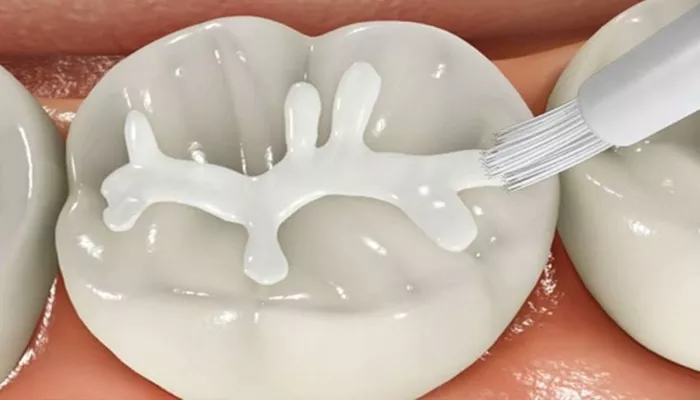Dental sealants are a thin, protective coating applied to the chewing surfaces of the back teeth, primarily molars and premolars. These surfaces often have grooves and pits that can trap food particles and bacteria, making them prone to cavities. By sealing these vulnerable areas, dental sealants act as a barrier, preventing plaque and acid from damaging the enamel.
Sealants are especially helpful for children and teenagers, but adults can benefit too, particularly those at higher risk of dental decay or gum disease. Proper application of dental sealants helps reduce the risk of cavities and contributes to maintaining healthy gums and overall oral hygiene.
A Step-by-Step Guide to Applying Dental Sealants
Step 1: Initial Dental Examination and Cleaning
Before applying dental sealants, a thorough dental examination is necessary. The dentist or dental hygienist inspects the teeth to determine if sealants are appropriate. They check for any signs of gum inflammation, cavities, or existing gum disease that need treatment before the procedure.
Once the teeth are evaluated, a professional cleaning is performed. The tooth surfaces must be free from plaque, food debris, and tartar. This cleaning ensures that the sealant adheres properly and the tooth surface is smooth and dry.
Why Cleaning Matters
Sealants require a clean, dry surface to bond effectively. If plaque or saliva contaminates the tooth surface, the sealant may fail to stick, reducing its protective benefits. Cleaning also helps reduce bacteria that contribute to gum disease and tooth decay.
Step 2: Tooth Preparation
After cleaning, the tooth needs to be prepared for sealant application. This process involves isolating the tooth and making sure it stays dry. Moisture control is essential because saliva or blood can interfere with the bonding process.
The dentist often uses cotton rolls or a rubber dam to keep the area dry. Sometimes, suction devices help remove saliva. The tooth surface may also be gently roughened with a mild acid solution called an etchant.
Etching the Tooth Surface
The etchant, usually containing phosphoric acid, is applied to the chewing surface for about 15 to 30 seconds. This step slightly roughens the enamel, increasing the surface area and improving the bond strength of the sealant. After etching, the tooth is thoroughly rinsed and dried again.
Step 3: Applying the Sealant Material
Once the tooth surface is clean, dry, and etched, the dental sealant material is carefully applied. Sealants are typically made from a plastic resin that flows easily into the pits and fissures of the tooth.
The dentist uses a small brush or applicator to spread the sealant evenly across the prepared surface. It is important to cover all grooves and pits where bacteria could accumulate. Some sealants are clear or tooth-colored, making them nearly invisible.
Step 4: Curing the Sealant
After the sealant is applied, it must harden or “cure” to form a strong protective layer. This is often done using a special curing light that emits blue light. The light activates the sealant material, causing it to harden quickly, usually within 20 to 60 seconds.
If the sealant is a self-curing type, it will harden without light, but this takes slightly longer. The dentist checks to ensure the sealant is fully set before moving on.
Step 5: Checking the Sealant and Bite Adjustment
After curing, the dentist examines the sealant for coverage and thickness. They check for any gaps or bubbles that could allow bacteria to enter beneath the sealant. If necessary, additional sealant may be applied to ensure complete coverage.
The dentist also asks the patient to bite down gently to check the sealant’s effect on the bite. Sometimes, the sealant can feel high or interfere with chewing. In such cases, the dentist trims or smooths the sealant to provide comfort and normal function.
Step 6: Post-Application Care and Follow-Up
After sealant placement, patients are advised to maintain good oral hygiene, including regular brushing and flossing. Although sealants protect against decay, they do not replace the need for proper dental care. Maintaining healthy gums is equally important to prevent gum inflammation and gum disease.
Dental sealants can last several years but should be checked regularly during dental visits. Over time, sealants can wear down or chip. The dentist may recommend reapplying or repairing the sealant to maintain protection.
Additional Tips to Protect Your Teeth and Gums
Applying dental sealants is just one part of a comprehensive approach to oral health. To further reduce the risk of cavities and gum disease, consider the following:
- Brush teeth twice daily with fluoride toothpaste
- Floss daily to remove plaque between teeth
- Limit sugary and acidic foods and drinks
- Visit the dentist regularly for professional cleanings and checkups
- Address early signs of gum inflammation promptly
FAQs
Are dental sealants safe?
Yes. Dental sealants are FDA-approved and have been used safely for decades. They contain materials that bond well with tooth enamel without causing harm.
Do sealants replace fluoride treatments?
No. Sealants provide physical protection on chewing surfaces, while fluoride strengthens the enamel chemically. Both are important and complementary for cavity prevention.
Can adults benefit from dental sealants?
Yes. Adults with deep grooves or those prone to cavities can benefit from sealants. Your dentist can advise if sealants are right for you based on your dental health.
Conclusion
Dental sealants offer an effective, painless, and quick method to protect teeth from decay. Following the step-by-step application process ensures the best outcome and long-lasting protection. Combined with good oral hygiene and regular dental visits, sealants help maintain healthy teeth and gums, reducing the risk of gum inflammation, gum disease, and cavities.
Understanding each step—from examination, cleaning, tooth preparation, sealant application, curing, to post-care—empowers patients to take an active role in their dental health. Consult with your dental care provider to see if sealants are suitable for you or your children and enjoy a confident smile protected against common dental problems.

